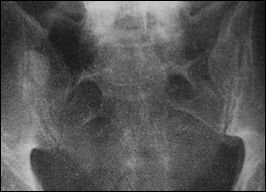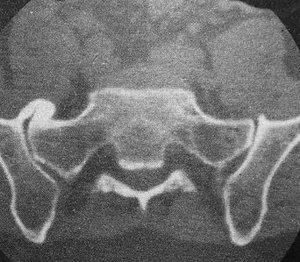Radiographic features associated with degenerative joint disease of the sacroiliac joint include: joint space loss, subchondral sclerosis and osteophytosis. With significant loss of subchondral bone of the ilium the joint may appear ankylosed with the sacrum. However, with close inspection of the trabeculae, one should be able to discern the lack of continuation of the trabeculae across the joint, which confirms the absence of ankylosis.
Osteophytosis is a prominent radiographic and pathologic characteristic of degenerative joint disease of the sacroiliac joint. It is more frequent in men than in women. Osteophytes can occur at any level in the joint but are most characteristic at the anterosuperior and anteroinferior margins of the joint. They may produce prominent focal radiopaque lesions, which can simulate the appearance of osteoblastic skeletal metastasis. With further growth of the osteophyte can extend across the anterior aspect of the articular cavity, causing periarticular bony ankylosis. This can simulate intra-articular bony ankylosis and can at times be falsely interpreted as ankylosing spondylitis. Fibrous ankylosis within the joint is typical of advanced degenerative joint disease of the sacroiliac joints; intra-articular bony ankylosis is exceedingly rare. This finding is generally associated with ankylosing spondylitis or one of the inflammatory arthropathies.
FIGURE 1: A spot on the sacrum demonstrates a radiopaque density overlying the left sacroiliac joint.


FIGURE 2: A large osteophytic formation is bridging the sacroiliac joint on one side, which on the plain film appears as a radiopaque density overlying the sacroiliac joint.
The figures are of a patient who was a 42-year-old male with a six year history of intermittent right-sided sacroiliac pain. The patient noted an incident of acute trauma: falling off a six foot sea wall, landing on his buttock and right hip. There was no apparent fracture to the hip or pelvis at the time of the incident. However, he experienced significant right hip and sacroiliac pain for several weeks, which gradually resolved, although three to four years later he developed intermittent right-sided sacroiliac pain.
Deborah Pate, DC, DACBR
San Diego, California
Click here for more information about Deborah Pate, DC, DACBR.





